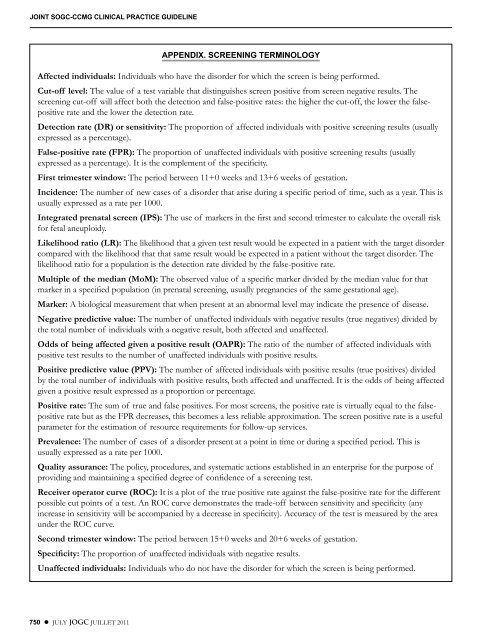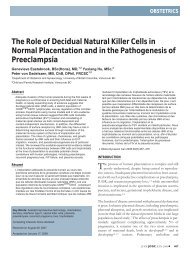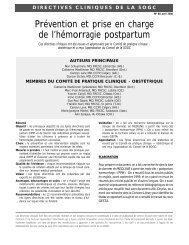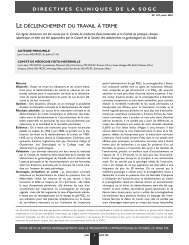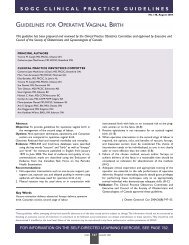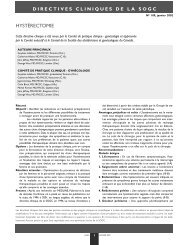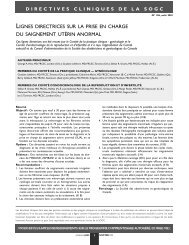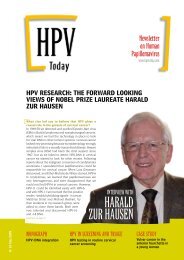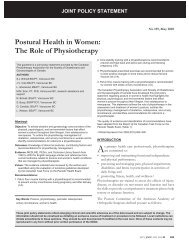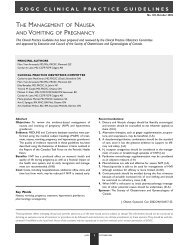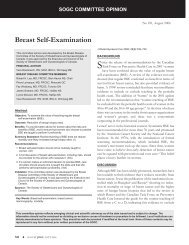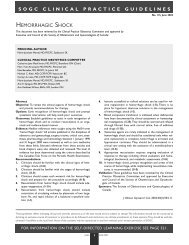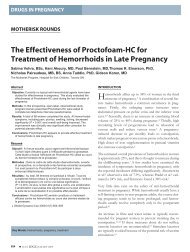Prenatal Screening for Fetal Aneuploidy in Singleton ... - SOGC
Prenatal Screening for Fetal Aneuploidy in Singleton ... - SOGC
Prenatal Screening for Fetal Aneuploidy in Singleton ... - SOGC
You also want an ePaper? Increase the reach of your titles
YUMPU automatically turns print PDFs into web optimized ePapers that Google loves.
JOINT <strong>SOGC</strong>-CCMG CLINICAL PRACTICE GuIDELINE<br />
750 l JULY JOGC JUILLET 2011<br />
APPENDIX. SCREENING TERMINOLOGY<br />
Affected <strong>in</strong>dividuals: Individuals who have the disorder <strong>for</strong> which the screen is be<strong>in</strong>g per<strong>for</strong>med.<br />
Cut-off level: The value of a test variable that dist<strong>in</strong>guishes screen positive from screen negative results. The<br />
screen<strong>in</strong>g cut-off will affect both the detection and false-positive rates: the higher the cut-off, the lower the falsepositive<br />
rate and the lower the detection rate.<br />
Detection rate (DR) or sensitivity: The proportion of affected <strong>in</strong>dividuals with positive screen<strong>in</strong>g results (usually<br />
expressed as a percentage).<br />
False-positive rate (FPR): The proportion of unaffected <strong>in</strong>dividuals with positive screen<strong>in</strong>g results (usually<br />
expressed as a percentage). It is the complement of the specificity.<br />
First trimester w<strong>in</strong>dow: The period between 11+0 weeks and 13+6 weeks of gestation.<br />
Incidence: The number of new cases of a disorder that arise dur<strong>in</strong>g a specific period of time, such as a year. This is<br />
usually expressed as a rate per 1000.<br />
Integrated prenatal screen (IPS): The use of markers <strong>in</strong> the first and second trimester to calculate the overall risk<br />
<strong>for</strong> fetal aneuploidy.<br />
Likelihood ratio (LR): The likelihood that a given test result would be expected <strong>in</strong> a patient with the target disorder<br />
compared with the likelihood that that same result would be expected <strong>in</strong> a patient without the target disorder. The<br />
likelihood ratio <strong>for</strong> a population is the detection rate divided by the false-positive rate.<br />
Multiple of the median (MoM): The observed value of a specific marker divided by the median value <strong>for</strong> that<br />
marker <strong>in</strong> a specified population (<strong>in</strong> prenatal screen<strong>in</strong>g, usually pregnancies of the same gestational age).<br />
Marker: A biological measurement that when present at an abnormal level may <strong>in</strong>dicate the presence of disease.<br />
Negative predictive value: The number of unaffected <strong>in</strong>dividuals with negative results (true negatives) divided by<br />
the total number of <strong>in</strong>dividuals with a negative result, both affected and unaffected.<br />
Odds of be<strong>in</strong>g affected given a positive result (OAPR): The ratio of the number of affected <strong>in</strong>dividuals with<br />
positive test results to the number of unaffected <strong>in</strong>dividuals with positive results.<br />
Positive predictive value (PPV): The number of affected <strong>in</strong>dividuals with positive results (true positives) divided<br />
by the total number of <strong>in</strong>dividuals with positive results, both affected and unaffected. It is the odds of be<strong>in</strong>g affected<br />
given a positive result expressed as a proportion or percentage.<br />
Positive rate: The sum of true and false positives. For most screens, the positive rate is virtually equal to the falsepositive<br />
rate but as the FPR decreases, this becomes a less reliable approximation. The screen positive rate is a useful<br />
parameter <strong>for</strong> the estimation of resource requirements <strong>for</strong> follow-up services.<br />
Prevalence: The number of cases of a disorder present at a po<strong>in</strong>t <strong>in</strong> time or dur<strong>in</strong>g a specified period. This is<br />
usually expressed as a rate per 1000.<br />
Quality assurance: The policy, procedures, and systematic actions established <strong>in</strong> an enterprise <strong>for</strong> the purpose of<br />
provid<strong>in</strong>g and ma<strong>in</strong>ta<strong>in</strong><strong>in</strong>g a specified degree of confidence of a screen<strong>in</strong>g test.<br />
Receiver operator curve (ROC): It is a plot of the true positive rate aga<strong>in</strong>st the false-positive rate <strong>for</strong> the different<br />
possible cut po<strong>in</strong>ts of a test. An ROC curve demonstrates the trade-off between sensitivity and specificity (any<br />
<strong>in</strong>crease <strong>in</strong> sensitivity will be accompanied by a decrease <strong>in</strong> specificity). Accuracy of the test is measured by the area<br />
under the ROC curve.<br />
Second trimester w<strong>in</strong>dow: The period between 15+0 weeks and 20+6 weeks of gestation.<br />
Specificity: The proportion of unaffected <strong>in</strong>dividuals with negative results.<br />
Unaffected <strong>in</strong>dividuals: Individuals who do not have the disorder <strong>for</strong> which the screen is be<strong>in</strong>g per<strong>for</strong>med.


